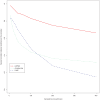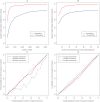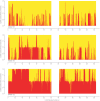Sensitive detection of chromosomal segments of distinct ancestry in admixed populations
- PMID: 19543370
- PMCID: PMC2689842
- DOI: 10.1371/journal.pgen.1000519
Sensitive detection of chromosomal segments of distinct ancestry in admixed populations
Abstract
Identifying the ancestry of chromosomal segments of distinct ancestry has a wide range of applications from disease mapping to learning about history. Most methods require the use of unlinked markers; but, using all markers from genome-wide scanning arrays, it should in principle be possible to infer the ancestry of even very small segments with exquisite accuracy. We describe a method, HAPMIX, which employs an explicit population genetic model to perform such local ancestry inference based on fine-scale variation data. We show that HAPMIX outperforms other methods, and we explore its utility for inferring ancestry, learning about ancestral populations, and inferring dates of admixture. We validate the method empirically by applying it to populations that have experienced recent and ancient admixture: 935 African Americans from the United States and 29 Mozabites from North Africa. HAPMIX will be of particular utility for mapping disease genes in recently admixed populations, as its accurate estimates of local ancestry permit admixture and case-control association signals to be combined, enabling more powerful tests of association than with either signal alone.
Conflict of interest statement
The authors have declared that no competing interests exist.
Figures








Similar articles
-
Exploring population admixture dynamics via empirical and simulated genome-wide distribution of ancestral chromosomal segments.Am J Hum Genet. 2012 Nov 2;91(5):849-62. doi: 10.1016/j.ajhg.2012.09.008. Epub 2012 Oct 25. Am J Hum Genet. 2012. PMID: 23103229 Free PMC article.
-
Enhanced statistical tests for GWAS in admixed populations: assessment using African Americans from CARe and a Breast Cancer Consortium.PLoS Genet. 2011 Apr;7(4):e1001371. doi: 10.1371/journal.pgen.1001371. Epub 2011 Apr 21. PLoS Genet. 2011. PMID: 21541012 Free PMC article.
-
Detecting Heterogeneity in Population Structure Across the Genome in Admixed Populations.Genetics. 2016 Sep;204(1):43-56. doi: 10.1534/genetics.115.184184. Epub 2016 Jul 20. Genetics. 2016. PMID: 27440868 Free PMC article.
-
Mapping of disease-associated variants in admixed populations.Genome Biol. 2011;12(5):223. doi: 10.1186/gb-2011-12-5-223. Epub 2011 May 30. Genome Biol. 2011. PMID: 21635713 Free PMC article. Review.
-
Prospective avenues for human population genomics and disease mapping in southern Africa.Mol Genet Genomics. 2020 Sep;295(5):1079-1089. doi: 10.1007/s00438-020-01684-8. Epub 2020 May 21. Mol Genet Genomics. 2020. PMID: 32440765 Free PMC article. Review.
Cited by
-
Blockwise HMM computation for large-scale population genomic inference.Bioinformatics. 2012 Aug 1;28(15):2008-15. doi: 10.1093/bioinformatics/bts314. Epub 2012 May 28. Bioinformatics. 2012. PMID: 22641715 Free PMC article.
-
PCAdmix: principal components-based assignment of ancestry along each chromosome in individuals with admixed ancestry from two or more populations.Hum Biol. 2012 Aug;84(4):343-64. doi: 10.3378/027.084.0401. Hum Biol. 2012. PMID: 23249312 Free PMC article.
-
The effect of genomic inversions on estimation of population genetic parameters from SNP data.Genetics. 2013 Jan;193(1):243-53. doi: 10.1534/genetics.112.145599. Epub 2012 Nov 12. Genetics. 2013. PMID: 23150602 Free PMC article.
-
Inference of population splits and mixtures from genome-wide allele frequency data.PLoS Genet. 2012;8(11):e1002967. doi: 10.1371/journal.pgen.1002967. Epub 2012 Nov 15. PLoS Genet. 2012. PMID: 23166502 Free PMC article.
-
Molecular and phenotypic distinction of the very recently evolved insular subspecies Mus musculus helgolandicus ZIMMERMANN, 1953.BMC Evol Biol. 2015 Aug 14;15:160. doi: 10.1186/s12862-015-0439-5. BMC Evol Biol. 2015. PMID: 26268354 Free PMC article.
References
Publication types
MeSH terms
Grants and funding
LinkOut - more resources
Full Text Sources
Other Literature Sources

